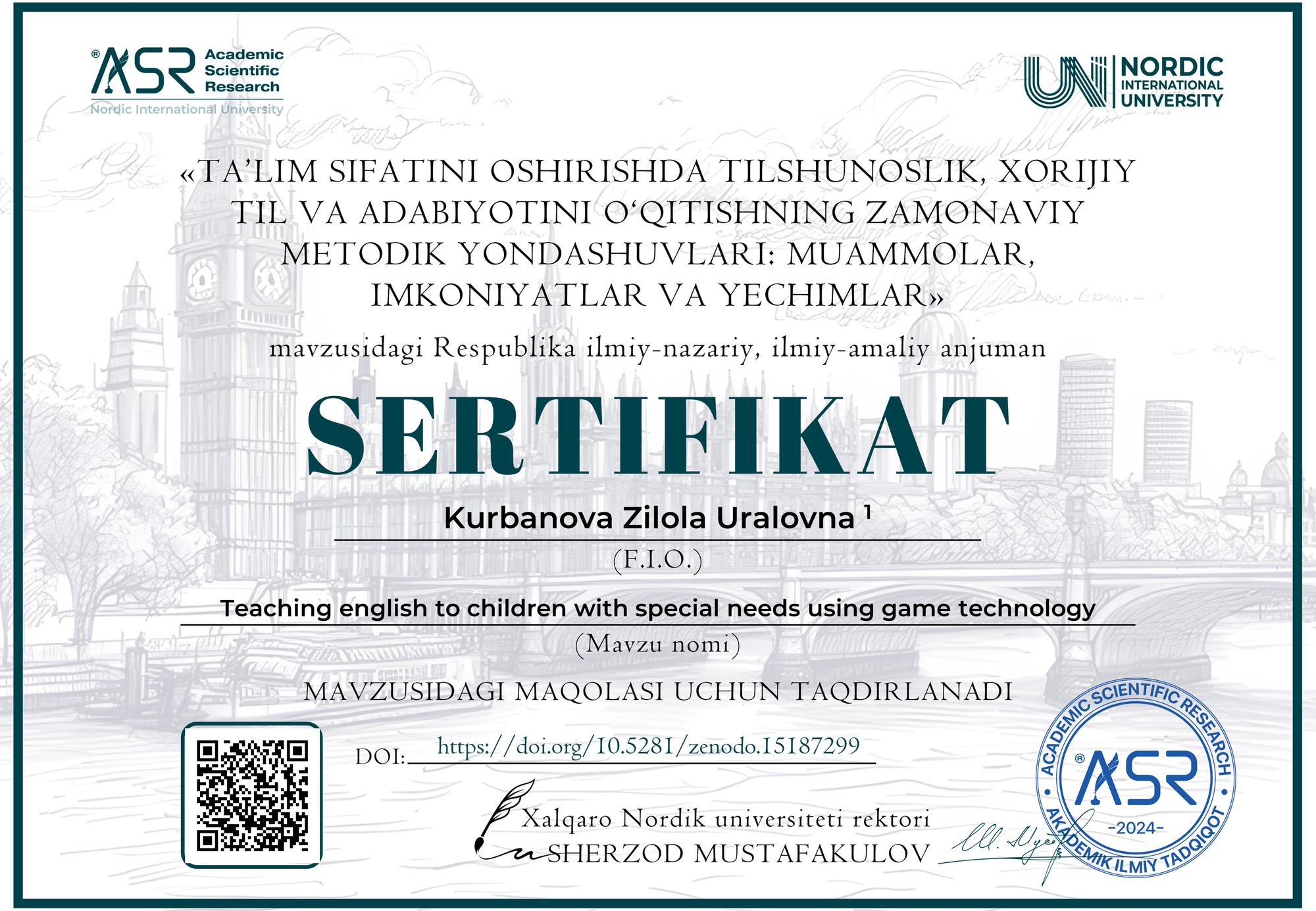Kurbanova Zilola Uralovna 1

DOI: https://doi.org/10.5281/zenodo.15187299
Google scholar: https://scholar.google.com/scholar?hl=ru&as_sdt=0%2C5&q=%22TEACHING+ENGLISH+TO+CHILDREN+WITH+SPECIAL+NEEDS+USING+GAME+TECHNOLOGY%22&btnG=
Zenodo community: https://zenodo.org/records/15187299
Nordic_press journal: https://research.nordicuniversity.org/index.php/nordic/article/view/2295
MAQOLANI YUKLAB OLISH
SERTIFIKATNI YUKLAB OLISH
REVIEW:
Kurbanova Zilola Uralovna’s article “Teaching English to Children with Special Needs Using Game Technology” presents a valuable exploration of the integration of game technologies into the educational process for children with special needs. As a current issue in the field of education, this topic highlights both the challenges and effective solutions to make learning more engaging and effective for children who face various physical, mental, or psychological obstacles.
Summary and Key Points:
The article begins by contextualizing the importance of supporting children with special needs, aligning this with the broader goals of inclusive education. The author emphasizes that these children require tailored educational methods and technologies to facilitate their development. Game technology is presented as a powerful tool to address these needs, offering an interactive, engaging, and adaptive approach to teaching.
Kurbanova identifies specific categories of special needs children, including those with hearing impairments, visual impairments, and speech defects. She explains how each group faces unique challenges in education and discusses how game technologies can help overcome these challenges. The games not only improve language acquisition but also foster emotional, cognitive, and social development.
The article draws on key educational theories, notably the work of Piaget, Vygotsky, Gardner, and Malaguzzi, who argue that learning through play is vital for children's overall development. These theorists highlight that play supports cognitive growth, social integration, and emotional well-being, all of which are particularly crucial for children with special needs.
The integration of game technologies into the learning process is backed by research in cognitive load theory and social integration. Game-based learning reduces cognitive load and allows children to interact with their peers, thus enhancing both language learning and social skills. Kurbanova further argues that gaming technologies provide individualized learning experiences, catering to different learning styles, such as visual, auditory, and kinesthetic.
Key Advantages:
Motivation and Engagement: By incorporating games into language learning, children are more motivated and engaged in the process. The competitive, interactive, and fun aspects of games keep children focused and eager to participate.
Social Interaction: The games encourage communication and social interaction, which are crucial for children who may experience isolation due to their special needs. Through games, they can build relationships and practice their language skills in a social context.
Cognitive and Emotional Development: Game-based learning also nurtures emotional intelligence and cognitive abilities. As children play, they are not only learning a language but also improving their decision-making, problem-solving, and critical thinking skills.
Individualized Learning: The use of games allows for a more personalized learning experience, as children can learn at their own pace and according to their specific needs.
Examples of Game-Based Learning Methods:
The article provides practical examples of how game technologies can be used to teach English to children with special needs:
Matching Games: These games help children learn vocabulary and improve word recognition by matching words with pictures.
Storytelling Games: Storytelling helps children practice their language skills by reading or retelling stories in English. This type of game promotes vocabulary development, narrative skills, and logical thinking.
Additionally, Kurbanova introduces various technological tools and methods such as interactive mobile applications, virtual classrooms, and video games, all of which play a role in enhancing the learning experience.
Critical Reflection:
The article provides a solid foundation for understanding the significance of game technologies in teaching English to children with special needs. However, while the benefits of using such technologies are clearly outlined, the article could benefit from a more in-depth analysis of the practical challenges faced by teachers when integrating these technologies into the classroom. For example, the issue of access to appropriate resources, technical infrastructure, and teacher training could be further explored to provide a more comprehensive view of the implementation process.
Moreover, while the examples provided, such as matching games and storytelling, are useful, a broader range of examples that include diverse game formats or platforms could offer readers more ideas on how to utilize game technology effectively. Additionally, further discussion on the long-term impact of game-based learning on children with special needs would enrich the analysis.
Conclusion:
In conclusion, Kurbanova’s article is an insightful contribution to the field of special education and game-based learning. The integration of game technology in teaching English to children with special needs is not only an innovative approach but also an effective means of promoting engagement, social interaction, and language development. This method addresses the unique challenges faced by children with special needs and helps them overcome barriers to learning. The article serves as an excellent starting point for educators and researchers interested in developing more inclusive and effective teaching strategies.
In the future, further research could explore the practical application of these technologies in different educational settings, examining how they can be adapted to suit the specific needs of various groups of children with special needs.



